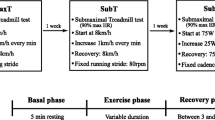Abstract
The present work quantifies, through principal components analysis (PCA) the relationships among the variability of breath-by-breath ventilatory parameters [minute-ventilation (VE), tidal volume (Vt), and respiratory rate (FR)] during a maximal progressive exercise test. The results show that the first and second eigenvalues of the covariant matrix contains almost 90% of the variables’ variance possible to see through the PCA, which means that the problem can be reduced by a two-dimensional analysis. The results show a close similarity between the global variability in two groups test, athletes and sedentary (control). For the athletes group, the parameter Vt is responsible for the high VE variability values while in the sedentary group the FR is more relevant for VE variability. The result improves the knowledge about respiratory variability during exercise, showing that Vt’s and FR’s variabilities contribute in different ways to global ventilation variability during a maximal cardiopulmonary exercise test in athletes and sedentary men.




Similar content being viewed by others
References
Carley DW, Shannon DC (1988) A minimal mathematical model of human periodic breathing. J Appl Physiol 65(3):1400–1409
Castro RRT, Antunes-Correa LM, Ueno LM, Rondon MUPB, Negrão CE, Nóbrega ACL (2010) Ventilation variability inversely correlates to ejection fraction in heart failure. Eur Respir J 36(6)
Castro RRT, Antunes-Correa LM, Ueno LM, Rondon MUPB, Negrão CE, Nóbrega ACL (2010) Reversal of periodic breathing after aerobic training in heart failure. Eur Respir J 35(6):1409–1411
Cherniack RM, Naimark A (1972) Respiration in health and disease. W.B. Saunders Company, Philadelphia
Corra U, Giordano A, Bosimini E, Mezzani A, Piepoli M, Coats AJ et al (2002) Oscillatory ventilation during exercise in patients with chronic heart failure: clinical correlates and prognostic implications. Chest 121(5):1572–1580
Ekkekakis P, Lind E, Hall EE, Petruzzello SJ (2008) Do regression-based computer algorithms for determining the ventilatory threshold agree? J Sports Sci 26:967–976
Fleg JL (2010) Breathing not properly during exercise: prognostic implications in heart failure. J Am Coll Cardiol 55:1824–1825
Garrard CS, Das R (1987) Sources of error and variability in the determination of the anaerobic threshold in humans. Respiration 51:137–145
Hey EN, Lloyd BB, Cunningham DJ et al (1996) Effects of various respiratory stimuli on the depth and frequency of breathing in man. Respir Physiol 1:193–205
Hoyer D, Maestri R, La Rovere MT, Pinna DG (2008) Autonomic response to cardiac dysfunction in chronic heart failure: a risk predictor based on autonomic information flow. Pacing Clin Electrophysiol 31(2):214–220
La Rovere MT, Bigger JT Jr, Marcus FI, Mortara A, Schwartz PJ (1998) Baroreflex sensitivity and heart-rate variability in prediction of total cardiac mortality after myocardial infarction. ATRAMI investigators. Lancet 14:478–484
Leite JJ, Mansur AJ, de Freitas HF, Chizola PR, Bocchi EA, Terra-Filho M et al (2003) Periodic breathing during incremental exercise predicts mortality in patients with chronic heart failure evaluated for cardiac transplantation. J Am Coll Cardiol 41(12):2175–2181
Lorenzi-Filho G, Genta PR, Figueiredo AC, Inoue D (2005) Cheyne-Stokes respiration in patients with congestive heart failure: causes and consequences. Clinics (Sao Paulo) 60(4):333–344
Machado SM, Osório RAL, Silva NS, Magini M (2010) Biomechanical analysis of the muscular power of martial arts athletes. Med Biol Eng Comp 48:573–577
Myers J, Goldsmith RL, Keteyian SJ et al (2010) The ventilatory anaerobic threshold in heart failure: a multicenter evaluation of reliability. J Card Fail 16:76–83
Neto OP, Magini M (2007) Electromiographic and kinematic characteristics of Kung Fu Yau-Man palm strike. J Electromyogr Kinesiol 18:1047–1052
Paiva JPLM, Kelencz CA, Paiva HM, Galvão RH, Magini M (2008) Adaptive wavelet EMG compression based on local optimization of filter banks. Physiol Meas 29:843–856
Ribeiro JP, Knutzen A, Rocco MB, Hartley LH, Colucci WS (1987) Periodic breathing during exercise in severe heart failure: reversal with milrinone or cardiac transplantation. Chest 92:555–556
Sun XG, Hansen JE, Beshai JF, Wasserman K (2010) Oscillatory breathing and exercise gas exchange abnormalities prognosticate early mortality and morbidity in heart failure. J Am Coll Cardiol 55:1814–1823
Svedahl K, MacIntosh BR (2003) Anaerobic threshold: the concept and methods of measurement. Can J Appl Physiol 28:299–323
Author information
Authors and Affiliations
Corresponding author
Rights and permissions
About this article
Cite this article
Castro, R.R.T., Magini, M., Pedrosa, S. et al. Principal components analysis to evaluate ventilatory variability: comparison of athletes and sedentary men. Med Biol Eng Comput 49, 305–311 (2011). https://doi.org/10.1007/s11517-010-0693-z
Received:
Accepted:
Published:
Issue Date:
DOI: https://doi.org/10.1007/s11517-010-0693-z




